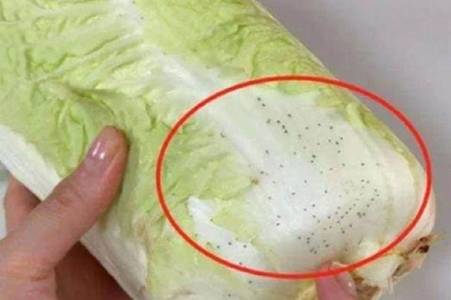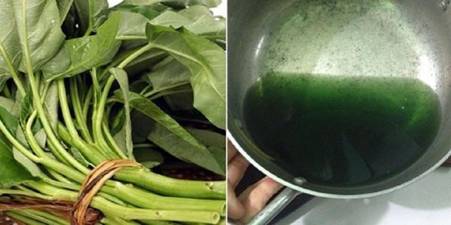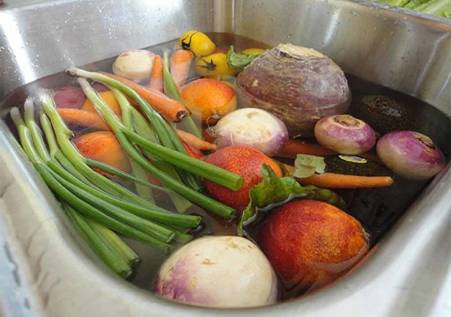Tips to Avoid Buying Pesticide-Laden Vegetables
– Unusual color: Vegetables that have been sprayed with pesticides or other chemicals often exhibit a greener hue compared to their untreated counterparts.
– Abnormal size: Vegetables treated with excessive growth stimulants and pesticides tend to have noticeably larger or smaller sizes than what is typically expected.
– Strange taste and odor: If, upon cooking, you detect any unusual colors, tastes, or odors, it is best to discard the vegetables immediately.
Identifying safe and healthy vegetables is crucial for protecting your well-being and that of your loved ones.

Handy tips to help homemakers distinguish between chemically-treated and organic produce. Illustration purposes only.
Vegetables Prone to Chemical Residues—Be Wary When Purchasing
In reality, certain types of vegetables tend to harbor higher levels of pesticides than others. The primary reason for this is that these particular crops are more susceptible to pest infestations. Secondly, their growth cycles are shorter, which means that by the time they reach consumers, residual pesticides may not have had sufficient time to break down naturally.
Listed below are some of the most pesticide-laden vegetables that, due to a lack of awareness, many individuals unknowingly consume daily. When ingested in substantial amounts, these chemical residues can pose significant health risks. Therefore, it is imperative to thoroughly clean and prepare these vegetables before cooking.

Illustration purposes only
Water Spinach
Consuming water spinach contaminated with lead can result in the accumulation of this toxic metal in various organs, including the brain, kidneys, liver, bones, bone marrow, and red blood cells. This can lead to a host of health issues, as reported by Kinh tế & Đô thị (Economic and Urban Newspaper).
By simply observing the physical characteristics and behavior during cooking, you can easily determine whether water spinach contains lead. Typically, after boiling water spinach, if you add lemon juice, the broth will turn a yellowish hue and appear slightly clearer. This occurs because the citric acid in the lemon juice causes the chlorophyll to break down, altering the color. However, if the broth turns dark green and remains unchanged when lemon juice is added, it indicates the presence of lead contamination.
Mustard Greens
According to the National Institute of Nutrition (under the Ministry of Health), mustard greens tend to attract more insects when grown in soil. Consequently, farmers often resort to excessive pesticide spraying and nitrogen fertilizer application shortly before harvesting. As a result, when consumed, the residual fertilizers and pesticides in the vegetables remain at dangerously high levels, as there hasn’t been sufficient time for natural degradation. This situation is particularly prevalent during the summer months, when pest control measures are more aggressively employed. Moreover, the growth cycle of summer mustard greens is typically shorter, rarely exceeding 60 days.
If you come across a bundle of mustard greens that appear unnaturally vibrant, with uniformly thick stems and no signs of insect damage, it is likely that they have been treated with excessive nitrogen fertilizers, specifically nitrates. It is best to refrain from consuming such greens raw.
Bean Sprouts
Bean sprouts, a familiar ingredient in many dishes, can be a source of concern if not chosen wisely. The sight of plump, perfectly rounded sprouts with pristine white bodies and minimal roots may appeal to homemakers. However, these seemingly perfect sprouts may have been produced using harmful chemical stimulants. A telltale sign of this is the cloudy liquid that emerges when these sprouts are stir-fried.
Effective Ways to Remove Pesticide Residues

– Blanching: Most pesticides used on fruits and vegetables are designed to kill insects and are susceptible to breakdown when exposed to high temperatures. Therefore, rinsing produce in hot water is an effective method to reduce pesticide residues. However, this technique may not be suitable for all types of fruits and vegetables, as some may wilt or lose their texture when subjected to high temperatures. Leafy greens, such as spinach, lettuce, cilantro, curly kale, celery, cabbage, chili peppers, beans, and broccoli, tend to respond better to this method.
The general procedure involves blanching the vegetables in boiling water for approximately 1-3 minutes (depending on the type), followed by a thorough rinse. This process significantly reduces the presence of pesticides.
– Soaking in salted water: Rinsing produce in salted water is a widely recommended practice. Washing vegetables in a mild salt solution (1% – 3% concentration) not only helps eliminate certain types of pesticides but also rids the produce of any hidden insects that may be lurking in crevices or along the veins on the backside of leaves. For vegetables like cabbage and lettuce, it is advisable to separate the leaves before soaking them in salted water.
– Soaking in rice water: Rice water, obtained after rinsing uncooked rice, has mild acidic properties and can effectively break down pesticide residues, which are also acidic in nature. Over time, the rice water loses its potency and becomes less effective at neutralizing harmful chemicals. Additionally, rice water has a viscous consistency and can absorb some of the pesticides and chemical residues present on the surface of the produce. Furthermore, since rice water does not contain any additional chemicals, it is considered safer for cleaning fruits and vegetables. It is particularly effective for washing small fruits like strawberries, mulberries, and grapes.
Note: When soaking vegetables, ensure that they are completely submerged in the solution. Afterward, for added safety, thoroughly rinse the produce under running water several times.
Source: Nguoiduatin































